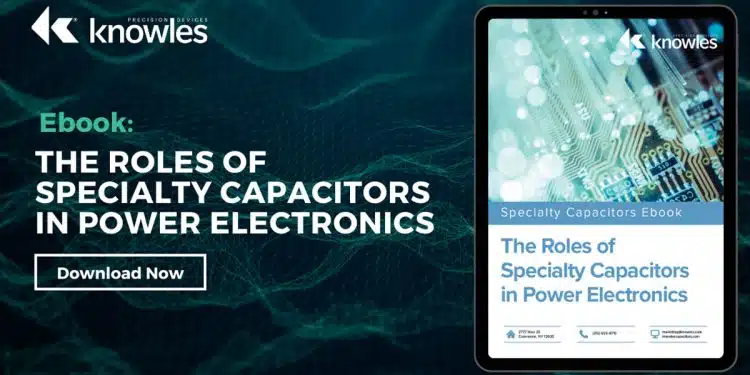Knowles Precision Devices is releasing new ebook, The Roles of Specialty Capacitors in Power Electronics that provides an overview of the most common capacitor types used in power electronics and discusses their key roles and design considerations, as well as the benefits of different types of capacitors available today.
Capacitors serve many crucial functions in power electronic circuits. Their ability to store electric charge makes them essential components for regulating and smoothing power flow.
Many of these capacitors are standard fare, but a few plays highly specialized, functional roles. To meet application-specific demands, these capacitors must be selected carefully based on function, size, and interoperability.
Each type of capacitor serves a specific purpose, such as providing clean power, minimizing noise, protecting components, storing energy, balancing voltage levels, etc. Understanding these specialty capacitors is critical to developing critical applications.
Additionally, engineers have choices between aluminum electrolytic, film and ceramic capacitors, and must consider factors like voltage rating, capacitance, ESR, frequency response, temperature stability, and physical size.
Ceramic capacitors are often well-suited for power electronics due to attributes like high capacitance density, low ESR/ESL, stability over temperature, high reliability, and small size. Film capacitors, on the other hand, can withstand a wide temperature range and often have higher capacitance value. However, film capacitors are large in size relative to their capacitance and often more expensive. With their wide operating range and robust nature, ceramic capacitors are an excellent choice to fulfill many of these demanding applications.
This new ebook, The Roles of Specialty Capacitors in Power Electronics provides an overview of the most common capacitor types used in power electronics and discusses their key roles and design considerations, as well as the benefits of different types of capacitors available today. It covers a variety of specialty capacitors – what they’re used for, how they’re implemented, and how to select the correct ones for an application. Capacitors covered include:
- Bypass Capacitors: Providing clean power to devices by filtering noise and suppressing transients on supply lines.
- Decoupling Capacitors: Isolating sensitive components from noise by storing and releasing energy to maintain steady supply voltage during transients.
- DC-Blocking Capacitors: Preventing unwanted DC offsets from corrupting the AC or RF signals in these systems.
- DC Link Capacitors: acting as buffers that smooth power delivery and minimize ripples.
- Safety Capacitors: Protecting circuits and mitigate energy hazards in high-voltage systems.
- EMI Filters: suppressing electromagnetic noise generated by switched-mode power supplies, motor drives, and other electronics.
- Snubber Capacitors: Absorbing voltage spikes, limiting over-voltages.
- Resonant Capacitors: Leveraging this resonance to oscillate at specific frequencies, storing and releasing energy.
- Flying Capacitors: Transferring charges between different voltage potentials in multi-level power inverters.
- Bootstrap Capacitors: Enabling efficient high-side switching in half-bridge and full-bridge power converters.
Capacitors satisfy critical needs in power electronics, from high-frequency filtering to energy storage and voltage balancing. Selecting the right capacitor depends on understanding these diverse roles and their electrical and physical requirements.































